|
|
|
Sort Order |
|
|
|
Items / Page
|
|
|
|
|
|
|
| Srl | Item |
| 1 |
ID:
117802
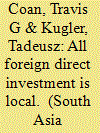

|
|
|
|
|
| Publication |
2012.
|
| Summary/Abstract |
This study focuses on the differences between Indian states in terms of banking infrastructure, size of the economic market and most importantly provincial-level political capacity that creates the pull of foreign direct investment (FDI). While the majority of the extant empirical literature examines national-level data, few studies analyze international capital formation at the provincial level and the dynamics of sub-national political capacity-that is, where allocations are made and policies are implemented. This study corrects for this deficiency. Using data at the provincial level in India over the period 2000-2005, we find an inverted-U-shaped relationship between provincial capacity and FDI, suggesting the presence of a critical point at which additional extractive capabilities have negative implications for foreign capital accumulation. The results suggest a number of important policy implications, allowing researchers to identify specific regions in which capacity is likely to facilitate investment, while also providing a political-economic model to better-forecast changes in investment at the sub-national level in India.
|
|
|
|
|
|
|
|
|
|
|
|
|
|
|
|
| 2 |
ID:
136060


|
|
|
|
|
| Summary/Abstract |
Like many other developing countries, South Asian nations have been experiencing increased foreign direct investment inflows over the past decade as developing countries get a larger share of cross-border investments that were once sent to developed countries. Nonetheless, South Asia’s inflows of foreign direct investment remain the lowest relative to gross domestic product among developing country regions. Why are South Asia’s foreign direct investment inflows so low and what lessons can be drawn for developing countries as a whole? The analysis in this article uses a novel empirical model that accounts for possible trends in convergence in the ratio of foreign direct investment to gross domestic product between countries and cross-sectional data for 78 countries from 2000 to 2011. The sample contains 52 developing countries. The analysis finds that two key factors are at work—high overall regulatory restrictions on foreign direct investment and specific restrictions placed on doing business with other countries. These factors include overall trade restrictiveness, which reduces the benefits to cross-border investments, and weak institutions to protect foreign investors and facilitate investment. Nonetheless, the potential for faster growth in intra- and inter-regional foreign direct investment flows is significant. The main factors leading to this conclusion are South Asia’s current low levels of foreign direct investment, the many unexploited opportunities for embodied knowledge transfer, and supply-chain linkages. The overall lessons for developing countries are that liberalizing policy constraints in both trade and foreign investment, keeping corporate tax rates modest, and improving governance and transparency could help to substantially improve foreign direct investment flows.
|
|
|
|
|
|
|
|
|
|
|
|
|
|
|
|
| 3 |
ID:
165386


|
|
|
|
|
| Summary/Abstract |
Using a panel cointegration approach, this study examines the relationship between aggregate consumption and GDP in colonial Malaya (1900–39) and post-independence Malaysia (1970–2009). The findings suggest that private consumption and GDP are cointegrated across the two forty-year periods, indicating a stable relationship in the long run. This is significant as the two periods are completely bipolar in terms of economic structure, stage of development and economic management. The vector error-correction models reveal that adjustment to long-run equilibrium is achieved through changes in both consumption and GDP, though the response of GDP to disequilibrium is stronger. Cointegration regressions of DOLS and FMOLS are used to estimate the marginal propensity to consume (MPC) between the two periods.
|
|
|
|
|
|
|
|
|
|
|
|
|
|
|
|
| 4 |
ID:
133653


|
|
|
|
|
| Publication |
2014.
|
| Summary/Abstract |
Empirical research in the New Institutional Economics tradition has concentrated on the degree to which institutional constraints on rulers protect property rights and foster growth through private investment. This view of institutions is overly narrow, neglecting the role of state capacity in particular. Both state authority and constraints on rulers matter for economic performance, but the relative strength of these effects depends upon a country's distance from the frontier of the world economy. Tests using a panel data set that covers up to 84 countries from the period 1960 to 2005 reveal that, in countries that have low Gross Domestic Product (GDP) per capita, constraints on rulers in the form of checks and balances affect neither the rate of productivity growth nor the growth of capital stock per worker. Basic state authority, however, has a strong, positive effect on both of these outcomes. The story is different for advanced industrial economies, where the effects of checks are positive, especially with respect to productivity growth. Institutional checks on rulers are thus not an agent of investment-based growth but support continued growth based upon innovation at the leading edge.
|
|
|
|
|
|
|
|
|
|
|
|
|
|
|
|
| 5 |
ID:
135520
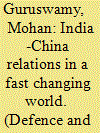

|
|
|
|
|
| Summary/Abstract |
This centaury has been good for India, so far. its economy has been bounding along, finally reflecting a closer correlation between promise and performance. the demographic trends have never been so propitious. Given the current trends and informed forecasts India’s Gross Domestic Product (GDP) is expected to double every seven or eight years. it is climbing closer to $ 2 trillion now. Thus, by, say, 2050, we could be looking at a GDP in real terms of over $ 40 trillion. if the current trends were to do slightly better, and be maintained, by 2050 or even earlier, India could conceivably emerge with the world’s largest GDP.
|
|
|
|
|
|
|
|
|
|
|
|
|
|
|
|
| 6 |
ID:
133436
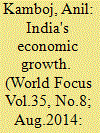

|
|
|
|
|
| Publication |
2014.
|
| Summary/Abstract |
with annual growth rate hovering below 5%, Asia's third-largest economy has been weighted down by high inflation, a weak currency and a drop in foreign investment. As per World bank's chief economist Kaushik Basu, poor governance and inadequate infrastructure are holding up growth in India.
|
|
|
|
|
|
|
|
|
|
|
|
|
|
|
|
| 7 |
ID:
095468


|
|
|
|
|
| Publication |
2010.
|
| Summary/Abstract |
Most analysts on the continent do not share donor nations' optimism that a big push in aid will make a big difference in the lives of poor Africans.
|
|
|
|
|
|
|
|
|
|
|
|
|
|
|
|
| 8 |
ID:
185676


|
|
|
|
|
| Summary/Abstract |
Gross domestic product (GDP), GDP per capita, and population are central to the study of politics and economics broadly, and conflict processes in particular. Despite the prominence of these variables in empirical research, existing data lack historical coverage and are assumed to be measured without error. We develop a latent variable modeling framework that expands data coverage (1500 AD–2018 AD) and, by making use of multiple indicators for each variable, provides a principled framework to estimate uncertainty for values for all country-year variables relative to one another. Expanded temporal coverage of estimates provides new insights about the relationship between development and democracy, conflict, repression, and health. We also demonstrate how to incorporate uncertainty in observational models. Results show that the relationship between repression and development is weaker than models that do not incorporate uncertainty suggest. Future extensions of the latent variable model can address other forms of systematic measurement error with new data, new measurement theory, or both.
|
|
|
|
|
|
|
|
|
|
|
|
|
|
|
|
| 9 |
ID:
101707


|
|
|
|
|
| Publication |
2010.
|
| Summary/Abstract |
The backbone of the Soviet economy was built during the period of industrialization before 1940, and in the post-war period from 1945-1960.Then the system failed after reaching its peak of growth in the 1970s. The decline dragged on until 1998. Russians paid a high price in the 1940s and the 1950s for building the foundation of a national industry, and civil freedoms in the 1990s. It is only now that the new Russia has a truly excellent opportunity to develop into a strong and prosperous country.
|
|
|
|
|
|
|
|
|
|
|
|
|
|
|
|
| 10 |
ID:
135527


|
|
|
|
|
| Summary/Abstract |
Much has been said about the 21st century being the Asian century. In the post-Cold War era, the focus of global politics has been shifting from Europe to Asia which is majority attributed to the phenomenal growth of several Asian countries. One of the most prominent amongst those features is the unprecedented rise of china. China is the second largest economy in the world with a gross domestic product (GDP) of approximately US$ 9 trillion. Its GDP growth rate stood at 7.7 percent in 2013.
|
|
|
|
|
|
|
|
|
|
|
|
|
|
|
|
| 11 |
ID:
094925
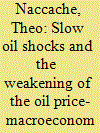

|
|
|
|
|
| Publication |
2010.
|
| Summary/Abstract |
Many papers have been documenting and analysing the asymmetry and the weakening of the oil price-macroeconomy relationship as off the early eighties. While there seems to be a consensus about the factors causing the asymmetry, namely adjustment costs which offset the benefits of low energy prices, the debate about the weakening of the relationship is not over yet. Moreover, the alternative oil price specifications which have been proposed by Mork (1989), Lee et al.(1995). and Hamilton (1996) to restore the stability of the relationship fail to Granger cause output or unemployment in post-1980 data. By using the concept of accelerations of the oil price, we show that the weakening of this relationship corresponds to the appearance of slow oil price increases, which have less impact on the economy. When filtering out these slow oil price variations from the sample, we manage to rehabilitate the causality running from the oil price to the macroeconomy and show that far from weakening, the oil price accelerations-GDP relationship has even been growing stronger since the early eighties.
|
|
|
|
|
|
|
|
|
|
|
|
|
|
|
|
| 12 |
ID:
168362
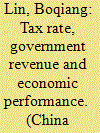

|
|
|
|
|
| Summary/Abstract |
The Laffer curve illustrates a theoretical relationship between rates of taxation and the resulting levels of government revenue. This paper explores the relationship between tax rate (direct tax on labor income), government revenue and economic performance in a perspective of the Laffer curve by applying Computable General Equilibrium (CGE) model. The results show that the top of China's Laffer curve is about 40%. The government should consider changes in the entire taxation system and not just changes in direct taxes while increasing direct tax rate. If China wants to maximize tax revenues, the direct tax rate should be 35%. We conduct a variety of sensitivity analyses and conclude that the government tax peak is always 5–10% earlier than the apex of the Laffer curve. So, if a country has reached the top of the Laffer curve, this paper strongly recommends that tax cuts will have positive implications for the economy and government revenue.
|
|
|
|
|
|
|
|
|
|
|
|
|
|
|
|
| 13 |
ID:
125330


|
|
|
|
|
| Publication |
2013.
|
| Summary/Abstract |
Indonesia`s economic growth continues to decelerate. It declined to 6.03% in the first quarter from the previous quarter, and reached a lower level of 5081% in the second quarter. This decline in economic activity is due to the slowdown of growth in various aspects of both production and the demand side of the economy.
In addition to the economic slowdown, the second quarter of 2013 shows deterioration in Indonesia`s balance of payment. The current account deficit is increasingly widened due to the decline in exports and increase in imports. Indonesia`s balance of trade also shows trade deficit and deterioration trend in its performance.
|
|
|
|
|
|
|
|
|
|
|
|
|
|
|
|
| 14 |
ID:
128393


|
|
|
|
|
| Publication |
2014.
|
| Summary/Abstract |
The August 2013 gross domestic product report by the US Bureau of Economic Analysis drew little attention, but it contained a fairly remarkable piece of data: Inflation-adjusted GDP per capita in the United States hit a new all-time high in the second quarter of 2013, the first time a new high had been reached since 2007. Real consumer spending has hit a new high, too, and auto sales are at levels not seen since before the financial crisis. Millions of Americans are still searching for work and suffering financial hardship, but on average, by the broadest measures of economic performance, America's Great Recession is over. Few nations across the Atlantic can say the same. The eurozone slipped back into recession in 2012 for the second time in four years, and remains in an economic state that can be accurately described as miserable. Real economic output among eurozone nations remains three percentage points below its 2008 peak. Eurozone unemployment sits near twelve percent in late 2013, higher than the US ever experienced at the peak of its recession. These problems are as deeply human as they are economic or political. Each percentage point rise in Europe's unemployment rate has boosted its suicide rate by 0.79 percent, according to a study published in the medical journal the Lancet.
|
|
|
|
|
|
|
|
|
|
|
|
|
|
|
|
| 15 |
ID:
106411


|
|
|
|
|
| Publication |
2011.
|
| Summary/Abstract |
The current economic mess has many alleged causes, from greedy bankers and over-generous Chinese lenders, to financially illiterate home buyers and regulators asleep at the wheel. Yet the crisis also revealed, and was in part due to, the limitations of the economic data we have relied on since the Great Depression. Celebrating ever-rising Gross Domestic Product (and for that matter rising corporate profits and share prices) blinded us to the increasingly serious risks we were taking.
|
|
|
|
|
|
|
|
|
|
|
|
|
|
|
|
| 16 |
ID:
156916
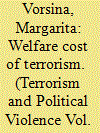

|
|
|
|
|
| Summary/Abstract |
Data from 117 countries over the period 2006 to 2011 are used to estimate a macroeconomic cross-country system of equations that examines the association between terrorism, self-reported life satisfaction, and national income. Results indicate that terrorism is negatively associated with life satisfaction, whereas no such association is found between terrorism and real GDP per worker. Stark contrasts are found, however, between OECD and non-OECD members. In all, our results suggest that the social costs of terrorism are potentially much higher than the economic costs, and measuring only the conventional economic costs of terrorism significantly underestimates the true costs.
|
|
|
|
|
|
|
|
|
|
|
|
|
|
|
|
|
|
|
|
|